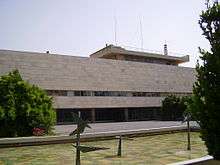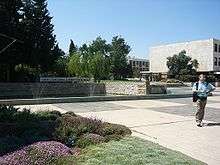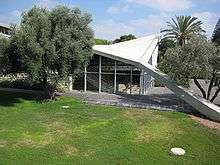Hebrew University of Jerusalem
The Hebrew University of Jerusalem (Hebrew: הַאוּנִיבֶרְסִיטָה הַעִבְרִית בְּיְרוּשָׁלַיִם, Ha-Universita ha-Ivrit bi-Yerushalayim; abbreviated HUJI) is Israel's second-oldest university, established in 1918, 30 years before the establishment of the State of Israel. The Hebrew University has three campuses in Jerusalem and one in Rehovot.[7] The world's largest Jewish studies library, the National Library of Israel, is located on its Edmond J. Safra Givat Ram campus.
 | |
| Type | Public research |
|---|---|
| Established | 24 July 1918 |
| Endowment | US$515.4 million (2018)[1] |
| Budget | US$802.4 million (2018)[2] |
| President | Asher Cohen |
| Rector | Barak Medina |
Administrative staff | 250 |
| Students | 23,000 |
| Undergraduates | 12,500 |
| Postgraduates | 5,000 |
| 2,200 | |
| Location | , |
| Campus | Urban |
| Nickname | Hebrew U, HUJI |
| Website | huji.ac.il |
 | |
| University rankings | |
|---|---|
| National | |
| ARWU[3] | 2–3 |
| Global | |
| ARWU[4] | 101–150 |
| QS[5] | 162 |
| THE[6] | 201–250 |
The university has 5 affiliated teaching hospitals including the Hadassah Medical Center, 7 faculties, more than 100 research centers, and 315 academic departments. As of 2018, a third of all the doctoral candidates in Israel were studying at the Hebrew University.
The first Board of Governors included Albert Einstein, Sigmund Freud, Martin Buber, and Chaim Weizmann. Four of Israel's prime ministers are alumni of the Hebrew University. As of 2018, 15 Nobel Prize winners, 2 Fields Medalists, and 3 Turing Award winners have been affiliated with the University.
History
.jpg)


One of the visions of the Zionist movement was the establishment of a Jewish university in the Land of Israel. Founding a university was proposed as far back as 1884 in the Kattowitz (Katowice) conference of the Hovevei Zion society.
The cornerstone for the university was laid on July 24, 1918. Seven years later, on April 1, 1925, the Hebrew University campus on Mount Scopus was opened at a gala ceremony attended by the leaders of the Jewish world, distinguished scholars and public figures, and British dignitaries, including the Earl of Balfour, Viscount Allenby, and Sir Herbert Samuel. The University's first Chancellor was Judah Magnes, who led the school as Chancellor from 1924 to 1935.[8] In 1935 to 1948 he led the school as president.[9]
By 1947, the University had become a large research and teaching institution. Sir Leon Simon was Acting President from 1948 to 1949, and he was succeeded as president by Professor Selig Brodetsky, who served from 1949 to 1952.[10] Plans for a medical school were approved in May 1949, and in November 1949, a faculty of law was inaugurated. In 1952, it was announced that the agricultural institute founded by the University in 1940 would become a full-fledged faculty.[11]
During the 1948 Arab–Israeli War, attacks were carried out against convoys moving between the Israeli-controlled section of Jerusalem and the University.[12] The leader of the Arab forces in Jerusalem, Abdul Kader Husseini, threatened military action against the university Hadassah Hospital "if the Jews continued to use them as bases for attacks."[13] After the April 1948 Hadassah medical convoy massacre, in which 79 Jews, including doctors and nurses, were killed, the Mount Scopus campus was cut off from Jerusalem.[14] British soldier Jack Churchill coordinated the evacuation of 700 Jewish doctors, students and patients from the hospital.[15]
When the Jordan government denied Israeli access to Mount Scopus, a new campus was built at Givat Ram in western Jerusalem and completed in 1958. In the interim, classes were held in 40 different buildings around the city.[16] Benjamin Mazar was President of the university from 1953 to 1961, Giulio Racah was Acting President from 1961 to 1962, and Eliahu Eilat was president from 1962 to 1968.[17]
The Terra Santa building in Rehavia, rented from the Franciscan Custodians of the Latin Holy Places, was also used for this purpose.[18] A few years later, together with the Hadassah Medical Organization, a medical science campus was built in the south-west Jerusalem neighborhood of Ein Kerem.
By the beginning of 1967, the students numbered 12,500, spread among the two campuses in Jerusalem and the agricultural faculty in Rehovot. After the unification of Jerusalem, following the Six-Day War of June 1967, the University was able to return to Mount Scopus, which was rebuilt. According to ARIJ, Israel confiscated 568 Dunams of land from the Palestinian village of Isawiya for the Hebrew University in 1968.[19] In 1981 the construction work was completed, and Mount Scopus again became the main campus of the University. Avraham Harman was President of the university from 1968 to 1983, Don Patinkin from 1983 to 1986, Amnon Pazy from 1986 to 1990, Yoram Ben-Porat from 1990 to 1992, Hanoch Gutfreund from 1992 to 1997, and Menachem Magidor from 1997 to 2009.[20]
On July 31, 2002, a member of a terrorist cell detonated a bomb during lunch hour at the University's "Frank Sinatra" cafeteria when it was crowded with staff and students. Nine people—five Israelis, three Americans, and one dual French-American citizen—were murdered and more than 70 wounded. World leaders, including Kofi Annan, President George W. Bush, and the President of the European Union issued statements of condemnation.[21][22]
Menachem Ben-Sasson was President of the university from 2009 to 2017, succeeded by Asher Cohen in 2017.[23]
In 2017 the Hebrew University of Jerusalem launched a marijuana research center, intended to "conduct and coordinate research on cannabis and its biological effects with an eye toward commercial applications."[24]
Campuses
Mount Scopus
Mount Scopus (Hebrew: Har HaTzofim הר הצופים), in the north-eastern part of Jerusalem, is home to the main campus, which contains the Faculties of Humanities, Social Sciences, Law, Jerusalem School of Business Administration, Baerwald School of Social Work, Harry S. Truman Research Institute for the Advancement of Peace, Rothberg International School, and the Mandel Institute of Jewish Studies.
The Rothberg International School features secular studies and Jewish/Israeli studies. Included for foreign students is also a mandatory Ulpan program for Hebrew language study which includes a mandatory course in Israeli culture and customs. All Rothberg Ulpan classes are taught by Israeli natives. However, many other classes at the Rothberg School are taught by Jewish immigrants to Israel.
The land on Mt. Scopus was purchased before World War I from Sir John Gray-Hill, along with the Gray-Hill mansion.[25] The master plan for the university was designed by Patrick Geddes and his son-in-law, Frank Mears in December 1919. Only two buildings of this original design were built: the David Wolffsohn University and National Library, and the Mathematics Institute, with the Physics Institute being probably built on the designs of their Jerusalem-based partner, Benjamin Chaikin.[26]
Housing for students at Hebrew University who live on Mount Scopus is located at the three dormitories located near the university. These are the Maiersdorf (מאירסדורף) dormitories, the Bronfman (ברונפמן) dormitories, and the Kfar HaStudentim (כפר הסטודנטים, Student Village).
Nearby is the Nicanor Cave, an ancient cave which was planned to be a national pantheon.
Edmond J. Safra, Givat Ram

The Givat Ram campus (recently renamed after Edmond Safra) is the home of the Faculty of Science including the Einstein Institute of Mathematics; the Israel Institute for Advanced Studies, the Center for the Study of Rationality, as well as the National Library of Israel, (JNUL).
Ein Kerem
The Faculties of Medicine and Dental Medicine and the Institute For Medical Research, Israel-Canada (IMRIC)[27] are located at the south-western Jerusalem Ein Kerem campus alongside the Hadassah-University Medical Center.
Rehovot

The Robert H. Smith Faculty of Agriculture, Food and the Environment[28] and the Koret School of Veterinary Medicine[29] are located in the city of Rehovot in the coastal plain. The Faculty was established in 1942 and the School of Veterinary Medicine opened in 1985. These are the only institutions of higher learning in Israel that offer both teaching and research programs in their respective fields. The Faculty is a member of the Euroleague for Life Sciences.
Libraries
The Hebrew University libraries and their web catalogs can be accessed through the HUJI Library Authority portal.[30]
Jewish National and University Library
The Jewish National and University Library is the central and largest library of the Hebrew University and one of the most impressive book and manuscript collections in the world. It is also the oldest section of the university. Founded in 1892 as a world center for the preservation of books relating to Jewish thought and culture, it assumed the additional functions of a general university library in 1920. Its collections of Hebraica and Judaica are the largest in the world. It houses all materials published in Israel, and attempts to acquire all materials published in the world related to the country. It possesses over five million books and thousands of items in special sections, many of which are unique. Among these are the Albert Einstein Archives, Hebrew manuscripts department, Eran Laor map collection, Edelstein science collection, Gershom Scholem collection, and a collection of Maimonides' manuscripts and early writings.
In his Will, Albert Einstein left the Hebrew University his personal papers and the copyright to them. The Albert Einstein Archives contain some 55,000 items.[31] In March, 2012 the University announced that it had digitized the entire archive, and was planning to make it more accessible online.[32][33][34] Included in the collection are his personal notes, love letters to various women, including the woman who would become his second wife, Elsa.
Subject-based libraries
.jpg)
In addition to the National Library, the Hebrew University operates subject-based libraries on its campuses, among them the Avraham Harman Science Library, Safra, Givat Ram; Mathematics and Computer Science Library, Safra, Givat Ram; Earth Sciences Library, Safra, Givat Ram; Muriel and Philip I. Berman National Medical Library, Ein Kerem; Central Library of Agricultural Science, Rehovot; Bloomfield Library for the Humanities and Social Sciences, Mt. Scopus; Bernard G. Segal Law Library Center, Mt. Scopus; Emery and Claire Yass Library of the Institute of Archaeology, Mt. Scopus; Moses Leavitt Library of Social Work, Mt. Scopus; Zalman Aranne Central Education Library, Mt. Scopus; Library of the Rothberg School for International Students, Mt. Scopus; Roberta and Stanley Bogen Library of the Harry S. Truman Research Institute for the Advancement of Peace, Mt. Scopus; and the Steven Spielberg Jewish Film Archive.
Rankings
According to the Academic Ranking of World Universities, the Hebrew University is the top university in Israel, overall the 87th-best university in the world, 33rd in mathematics, between 76th and 100th in computer science, and between 51st and 75th in business/economics.[36] In 2015, the Center for World University Rankings ranked the Hebrew University 23rd in the world and the top in Israel in its World University Rankings.[37] The Hebrew University consistently ranks as Israel's best university in mathematics, and among the best worldwide. It was ranked as the 11th best institution in mathematics worldwide in 2017, 19th best in 2018 and 21st best in 2019.[38]
Friends of the University
The university has an international Society of Friends organizations covering more than 25 countries. Canadian Friends of the Hebrew University of Jerusalem (CFHU), founded in 1944 by Canadian philanthropist Allan Bronfman, promotes awareness, leadership and financial support for The Hebrew University of Jerusalem. CFHU facilitates academic and research partnerships between Canada and Israel as well as establishing scholarships, supporting research, cultivating student and faculty exchanges and recruiting Canadian students to attend the Rothberg International School. CFHU has chapters in Montreal, Ottawa, Toronto, Winnipeg, Edmonton, Calgary and Vancouver.
The American Friends of the Hebrew University (AFHU) is a not-for-profit 501(c)3 organization that provides programs, events and fundraising activities in support of the university. It was founded by the American philanthropist, Felix M. Warburg in 1925. Supported by its founder, Stephen Floersheimer, and headed by Eran Razin, Floersheimer Studies is a singular program, publishing studies in the field of society, governance and space in Israel. It was established in 2007 replacing the Floersheimer Institute for Policy Studies of 1991.[39]
Faculty
- Dorit Aharonov, computer science
- Lydia Aran, scholar of Buddhism
- Robert Aumann, 2005 Nobel Prize laureate for Economics
- Shlomo Avineri, Political Science
- Yishai Bar, law
- Yehoshua Bar-Hillel, linguistics
- Yaacov Bar-Siman-Tov, international relations
- Aharon Barak, former President of the Israeli Supreme Court
- Yehuda Bauer, Holocaust history
- Jacob Bekenstein, physics
- Norman Bentwich, international relations
- Ernst David Bergmann, chairman of Israeli Atomic Energy Commission
- Martin Buber, religion & Jewish philosophy
- Howard Cedar, Chairperson, Developmental Biology & Cancer Research, IMRIC
- Ilan Chet, agricultural biotechnology
- Richard I. Cohen, history
- Avishai Dekel Andre Aisenstadt Chair of Theoretical Physics
- Shmuel Eisenstadt, sociology
- Menachem Elon, former Deputy President of the Israeli Supreme Court
- Adolf Abraham Halevi Fraenkel, mathematics
- Hillel Furstenberg, mathematics, Israel Prize Winner
- Leah Goldberg (1911–1970), poet
- Asher Dan Grunis, Supreme Court Justice
- Louis Guttman, social sciences and statistics
- Ephraim Halevy, Mossad chief
- Lumír Ondřej Hanuš, analytic chemist
- Gabriel Herman, Historian
- Daniel Kahneman, 2002 Nobel Prize laureate for Economics
- Ruth Kark, geography of (Eretz) Israel
- Elihu Katz, communication
- Aharon Katzir, chemistry
- David Kazhdan, mathematics
- Baruch Kimmerling, sociology
- Roger D. Kornberg, visiting professor, 2006 Nobel Prize laureate for chemistry
- David Kretzmer, law
- Ruth Lapidoth, law
- Ruth Lawrence, mathematics
- Yeshayahu Leibowitz, biochemistry and Jewish philosophy
- Avigdor Levontin, law
- Nehemia Levtzion (1935—2003), scholar of African history, Near East, Islamic, and African studies, President of the Open University of Israel, and Executive Director of the Van Leer Jerusalem Institute
- Amia Lieblich, psychology
- Elon Lindenstrauss, mathematics, laureate of the 2010 Fields Medal
- Joram Lindenstrauss, mathematics, Israel Prize Winner
- Avishai Margalit, philosophy Israel Prize Winner
- Amihai Mazar, archaeology, Israel Prize Winner
- Benjamin Mazar. archaeologist, Israel Prize Winner, former University president and rector
- Jacob (Kobi) Metzer, economic historian, professor, and the eighth President of the Open University of Israel
- Eugen Mittwoch, semitic languages, guest professor in 1924 (famous as head of German Nachrichtenstelle in World War One)
- George Mosse, history
- Bezalel Narkiss, art history
- Amnon Netzer, Jewish Studies and history
- Ehud Netzer (1934–2010), archaeology
- Yaakov Nahmias, bioengineering
- Anat Ninio, psychology
- Mordechai Nisan, education
- Dan Pagis, literature
- Nurit Peled-Elhanan, education
- Tsvi Piran, astrophysics
- Eliezer E. Goldschmidt, agriculture
- Joshua Prawer, history
- Michael O. Rabin, computer science and mathematics, Israel Prize Winner and recipient of the Turing Award.
- Giulio Racah, physics
- Frances Raday, law
- Aharon Razin, Researcher, IMRIC
- Eliyahu Rips, mathematics
- Mordechai Rotenberg, social work
- Gershom Scholem, Jewish mysticism
- Eliezer Schweid, Jewish philosophy
- Ehud de Shalit, number theorist
- Zlil Sela, mathematics
- Nir Shaviv, astrophysics
- Saharon Shelah, mathematics
- Avigdor Shinan, Hebrew literature
- Avraham Steinberg, medical ethics
- Zeev Sternhell, political science
- Hayim Tadmor, Assyriology
- Jacob Talmon, history
- Gadi Taub, social sciences
- Amos Tversky, psychology
- Claude Vigée, French literature
- Avi Wigderson, computer science and mathematics
- Hanna Yablonka, Holocaust history
- Joseph Yahalom, Hebrew poetry
- S. Yizhar, writer
- Raphael D. Levine, chemist
- Yuval Noah Harari, history
Notable alumni
Major award laureates
- Fields Medal laureate: Jean Bourgain (1994), Elon Lindenstrauss (2010)
- Nobel Prize laureates: Daniel Kahneman (economics 2002), David Gross (physics 2004), Avram Hershko (chemistry 2004), Aaron Ciechanover (chemistry 2004), Robert Aumann (economics 2005), Roger D. Kornberg (chemistry 2006), and Ada Yonath (chemistry 2009)
- Turing Award laureates: Michael O. Rabin (1976), Richard E. Stearns (1993), Shafi Goldwasser (2012)
Political leaders
- Ambassador Yael Rubinstein
- Members of the Knesset: Colette Avital, Yael Dayan, Taleb el-Sana, Dalia Itzik, Roman Bronfman, David Rotem, Ahmed Tibi, Avigdor Lieberman, Dov Khenin, Danny Danon, Shulamit Aloni, Rachel Adato, Ze'ev Elkin, Roni Bar-On, Ze'ev Bielski, Yohanan Plesner, David Rotem, Yuval Steinitz, Dan Meridor, Yisrael Katz, Jamal Zahalka, Shai Hermesh, Zvulun Orlev, Menachem Ben-Sasson, Ya'akov Ne'eman, Geulah Cohen, Bechor-Shalom Sheetrit
- Jerusalem city council members: Ofer Berkovitch
- Presidents of Israel: Ephraim Katzir, Yitzhak Navon, Moshe Katsav, Reuven Rivlin
- Prime Ministers of Israel: Ehud Barak, Ariel Sharon, Ehud Olmert
- Supreme Court Justices: Aharon Barak, Dorit Beinisch, Menachem Elon, Elyakim Rubinstein, Meir Shamgar, Jacob Turkel, Yitzhak Zamir, Salim Joubran, Uri Shoham
By profession
- Academics: Emanuel Adler, Michael Albeck, Yoram Ben-Porat, Ahron Bregman, Richard I. Cohen, Uri Davis, Amitai Etzioni, Esther Farbstein, Gerson Goldhaber, Daphna Hacker, Haim Harari, Joshua Jortner, Efraim Karsh, Asa Kasher, Walter Laqueur, Alexander Levitzki, Saul Lieberman, Avishai Margalit, Jacob (Kobi) Metzer, Dana Olmert, Neri Oxman, Dana Pe'er, Uriel Reichman, Miri Rubin, Eli Salzberger, Amit Schejter, Michael Sela, Igal Talmi, Benjamin Elazari Volcani, Menahem Yaari, Ada Yonath
- Activists: Dorit Reiss, Elie Yossef
- Anthropologist: Eliane Karp
- Archaeologists: Ruth Amiran, Trude Dothan, Aren Maeir, Amihai Mazar, Benjamin Mazar, Eilat Mazar, Yigael Yadin
- Astronomers: David H. Levy
- Biology and biochemistry: Sarah Spiegel (1974)[40]
- Botanists: Daniel Chamovitz, Alexander Eig
- Business: Kobi Alexander (former CEO and founder of Comverse Technology), Léo Apotheker (former CEO of Hewlett-Packard and SAP), Dina Dublon (Board member of Microsoft, Accenture and PepsiCo), Maxine Fassberg (former CEO of Intel Israel), Orit Gadiesh (Chairman of Bain & Company), Eli Hurvitz (CEO 1976–2002 Teva Pharmaceuticals), Gil Shwed (CEO and chairman Check Point Software Technologies)
- Chemists: Yitzhak Apeloig, Adam Heller, Dan Meyerstein, Renata Reisfeld
- Educators: Brother Rafael S. Donato FSC, Ed.D., was a Filipino De La Salle Brother and was the past President of De La Salle University Manila, University of St. La Salle, De La Salle Lipa, La Salle Green Hills and De La Salle Araneta University.
- Film, theatre, show business: Joseph Cedar, Natalie Portman, Uri Zohar
- Foreign service: Naomi Ben-Ami, Gabriela Shalev, Rafael Harpaz
- Journalists: Khaled Abu Toameh, Ron Ben-Yishai, Nahum Barnea, Boaz Evron, Amos Kenan, Sayed Kashua, Amira Hass, Akiva Eldar, Yossi Melman, Meron Benvenisti, Tom Segev, Haviv Rettig, Dan Margalit, Ya'akov Ahimeir, Michael Bar-Zohar, David Witzthum, Haim Gouri, Ehud Yaari, Zvi Yehezkeli
- Historians: Esther Farbstein, Yuval Noah Harari, Itamar Rabinovich, Ron Robin
- Law
- Judges: Elisheva Barak-Ussoskin
- Lawyers: Yoram Dinstein, Meir Shmuel Gabay, Elias Khoury, Menachem Mazuz, Ya'akov Ne'eman, Itzhak Nener, Malcolm Shaw
- Law professor: Dorit Reiss
- Mathematicians: Rami Grossberg (1986), Joram Lindenstrauss (1962), Moshe Machover (1962), Menachem Magidor, Amnon Pazy, Oded Schramm (1987), Saharon Shelah (1969)
- Physicists: Amikam Aharoni, David Gross, Haim Harari, Max Jammer, Igal Talmi, Micha Tomkiewicz
- Psychologists: Shlomo Breznitz, Asher Cohen
- Religion
- Clergy: Malcolm Ranjith, Archbishop of the Roman Catholic Archdiocese of Colombo, 2nd Sri Lankan to be made a cardinal, Patriarch Theophilos III of Jerusalem
- Theologians: Fr Malachi Martin, Yigal Arnon
- Soldiers: Yishai Beer, Uzi Dayan, Yuval Neria, Yonatan "Yoni" Netanyahu
- Sports: Itzik Kornfein, Shaul Ladany, Adin Talbar, Yochanan Vollach
- Writers: Yehuda Amichai, Galila Ron-Feder Amit, Aharon Appelfeld, Netiva Ben-Yehuda, Elias Chacour, Yael Dayan, Yuval Elizur, Helen Epstein, Jonah Frankel, David Grossman, Dmitry Glukhovsky, Batya Gur, Shifra Horn, Amos Oz, A. B. Yehoshua, Amnon Jackont, Amalia Kahana-Carmon, Yehoshua Kenaz, Miriam Roth, Amir Segal, Anton Shammas, Gideon Telpaz, Natan Yonatan
Yissum Research Development Company
Yissum Research Development Company is the university's technology transfer company, founded in 1964. Yissum owns all the intellectual property of the researchers and employees of the Hebrew University. Since its formation Yissum has founded more than 80 spin-off companies such as: Mobileye, BriefCam, HumanEyes, OrCam, ExLibris, BioCancell and many more. Yissum is led by Yaacov Michlin and other leaders in the business industry such as: Tamir Huberman,[41] Dov Reichman, Shoshi Keinan, Ariela Markel and Michal Levy. Yissum is also a member of ITTN (Israel Technology Transfer Organization).
See also
- Einstein Papers Project
- Yehezkel Kaufman
- List of Israeli universities and colleges
References
- President’s Report 2019
- President’s Report 2019
- "Academic Ranking of World Universities 2019: USA". Shanghai Ranking Consultancy. Retrieved August 16, 2019.
- "Academic Ranking of World Universities 2019". Shanghai Ranking Consultancy. 2019. Retrieved August 16, 2019.
- "QS World University Rankings® 2021". Quacquarelli Symonds Limited. 2020. Retrieved June 10, 2020.
- "World University Rankings 2020". THE Education Ltd. Retrieved September 14, 2019.
- "The Hebrew University of Jerusalem – About". Huji.ac.il. Retrieved September 6, 2011.
- "Office of the President | האוניברסיטה העברית בירושלים | The Hebrew University of Jerusalem". New.huji.ac.il. 2017-09-01. Retrieved 2020-02-18.
- "Office of the President | האוניברסיטה העברית בירושלים | The Hebrew University of Jerusalem". New.huji.ac.il. 2017-09-01. Retrieved 2020-02-18.
- "Office of the President | האוניברסיטה העברית בירושלים | The Hebrew University of Jerusalem". New.huji.ac.il. 2017-09-01. Retrieved 2020-02-18.
- Weitz, Yechiam (March 15, 2011). "The subversives on the hill". Haaretz. Retrieved September 6, 2011.
- The Palestine Post, April 14, 1948, p. 3
- 'Husseini Threatens Hadassah', The Palestine Post, March 18, 1948, p. 1
- Victims of Hadassah massacre to be memorialized, Judy Siegel-Itzkovich, Jerusalem Post, April 7, 2008.
- "Fighting Jack Churchill Survived A Wartime Odyssey Beyond Compare". Wwiihistorymagazine.com. 1941-12-27. Retrieved 2014-03-08.
- International Dictionary of University Histories. Retrieved September 6, 2011.
- "Office of the President | האוניברסיטה העברית בירושלים | The Hebrew University of Jerusalem". New.huji.ac.il. 2017-09-01. Retrieved 2020-02-18.
- "Jerusalem: Architecture in the British Mandate Period". Jewishvirtuallibrary.org. Retrieved September 6, 2011.
- 'Isawiya Town Profile, ARIJ, 2012, p. 14
- "Office of the President | האוניברסיטה העברית בירושלים | The Hebrew University of Jerusalem". New.huji.ac.il. 2017-09-01. Retrieved 2020-02-18.
- "HUJI Memorial Pages". Memorial.huji.ac.il. July 31, 2002. Retrieved September 6, 2011.
- "Terrorist bombing at Hebrew University cafeteria". Mfa.gov.il. Archived from the original on December 13, 2010. Retrieved September 6, 2011.
- "Office of the President | האוניברסיטה העברית בירושלים | The Hebrew University of Jerusalem". New.huji.ac.il. 2017-09-01. Retrieved 2020-02-18.
- JTA (2017-04-07). "Hebrew University Creates a Buzz With New Marijuana Research Center". Haaretz. Retrieved 2017-04-11.
- Diana Dolev (1998). "Architectural Orientalism In the Hebrew University - The Patrick Geddes and Frank Mears Master-Plan". Assaph, Section B, Studies in art history, no. 3, 217-234. Tel Aviv: Tel-Aviv University, Faculty of Fine Arts. Archived from the original on 2012-11-12. Retrieved September 6, 2011.
- Diana Dolev (2016). The Planning and Building of the Hebrew University, 1919–1948: Facing the Temple Mount. Lexington Books. pp. 67–76. ISBN 9780739191613. Retrieved 26 July 2018.
- "About Us — Institute for Medical Research Israel-Canada (IMRIC)". imric.org. 2014-05-15. Retrieved 2014-05-19.
- "Faculty of Agricultural, Food and Environmental Quality Sciences". Agri.huji.ac.il. Retrieved September 6, 2011.
- "Koret School of Veterinary Medicine". Departments.agri.huji.ac.il. Retrieved September 6, 2011.
- "lib-authority.huji.ac.il". lib-authority.huji.ac.il. 2013-07-26. Retrieved 2014-05-19.
- Sela, Shimrit (March 15, 2011). "Albert Einstein's bequest to the Hebrew University". Haaretz. Retrieved September 6, 2011.
- Rabinovitch, Ari (March 20, 2012). "Einstein the scientist, dreamer, lover: online". Reuters. Retrieved March 20, 2012.
- "Einstein papers to go digital on the Web". Space Daily. March 19, 2012. Retrieved March 20, 2012.
- Doyle, Carmel (March 20, 2012). "University digitises Einstein archives via new website". Silicon Republic. Retrieved March 20, 2012.
- Albert Einstein Portrait by Leonid Pasternak. Mathematics and Computer Science Library of the Hebrew University of Jerusalem, 2016.
- Academic Ranking of World Universities 2015, published by Shanghai Jiao Tong University in 2015.
- "Top 100". Center for World University Rankings. 2013. Retrieved July 17, 2013.
- "ShanghaiRanking's Global Ranking of Academic Subjects 2019 - Mathematics | Shanghai Ranking - 2019". Shanghai Ranking. Retrieved 2020-02-18.
- "Floersheimer Studies". en.fips.huji.ac.il. Retrieved 2017-08-16.
- "Sarah Spiegel, Ph.D." Asthma and Allergic Diseases Cooperative Research Center. 2010. Retrieved 2 September 2015.
- "Tamir Huberman - Israel | LinkedIn". Il.linkedin.com. Archived from the original on 2013-11-06. Retrieved 2014-05-19.
External links
| Wikimedia Commons has media related to Hebrew University of Jerusalem. |